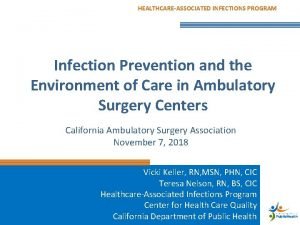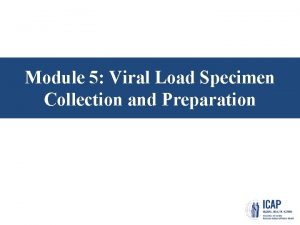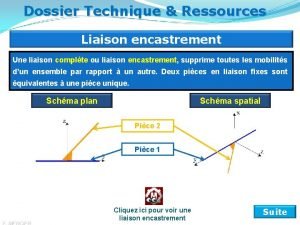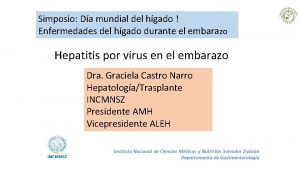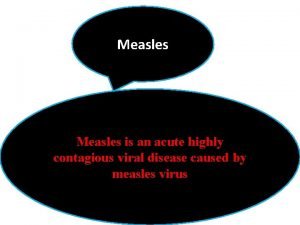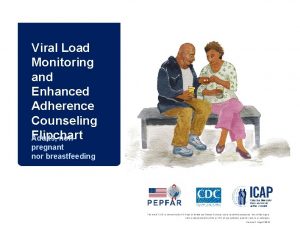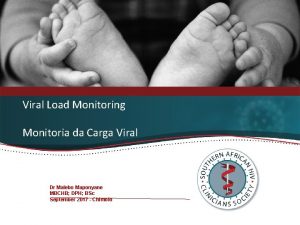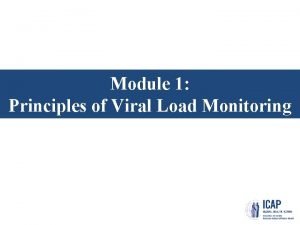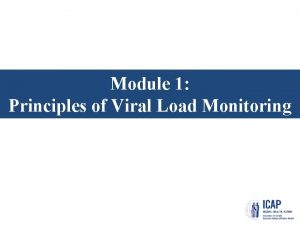Viral Load Monitoring and Enhanced Adherence Flipchart Counseling






















































- Slides: 54

Viral Load Monitoring and Enhanced Adherence Flipchart Counseling Pregnant and Breastfeeding Women The mark “CDC” is owned by the US Dept. of Health and Human Services and is used with permission. Use of this logo is not an endorsement by HHS or CDC of any particular product, service, or enterprise.

This job tool was created by ICAP at Columbia University with funding from the U. S. President’s Emergency Plan for AIDS Relief (PEPFAR) through the Centers for Disease Control and Prevention (CDC) under the terms of cooperative agreement #U 2 GGH 000994. Its contents are solely the responsibility of the authors and do not necessarily represent the views of the U. S. Government. This flipchart is intended for use by health care workers to provide information to pregnant and breastfeeding women living with HIV and their families. For questions about the contents or use, please contact ICAP at icap-communications@columbia. edu.

HOW TO USE THE VIRAL LOAD MONITORING AND ENHANCED ADHERENCE COUNSELING FLIPCHART The purpose of this flipchart is to provide pregnant and breastfeeding women who are receiving antiretrovirals (ARVs) information about viral load monitoring—including the meaning of viral load results and implications for transmission to their newborns—as well as guidance on adherence assessment and counseling, especially for those with elevated viral loads who warrant enhanced adherence counseling. It was developed for use by a range of health care workers (e. g. adherence counselors, doctors, nurses, pharmacists, community health workers) who work with pregnant and breastfeeding women living with HIV and their families Each card, or set of cards, focuses on a specific topic important in the care and support of pregnant and breastfeeding women receiving ART who are undergoing viral load testing, or who already have a viral load result. Topics are color-coded for ease of use. Directions on how to use the flip chart: • Place flip chart on table so that the patient has a good view of the pictures while you can read the side with notes. • Key messages for patients and instructions to providers are in bold. • There are notes to prompt and guide discussion with the patient, including questions to review covered material and assess the patient’s understanding. • There are cards for specific visits, including when starting ARVs, when undergoing a viral load test, and when results are available. There is another set of cards to guide the discussion with the women whose viral load result 1000 or less, and another set if viral load result is greater than 1000. • A separate document, the Enhanced Adherence Plan tool, should be used in conjunction with this counselling flipchart to assess and document findings and the patient’s plan; it should be included in the patient’s file. • After the first enhanced adherence counseling session (second and beyond), begin the session with card 18 and repeat cards 517 as needed. .


Card Topic (also shown to patient) KEY MESSAGES: ➢ Also shown to the patients Let’s Review: • Points to guide review with the patient Image from card front TALKING POINTS: • Some instructions for providers • Notes to prompt and guide discussion • Key points are bolded Document: Tells providers which forms to use to document discussions with the patient Provider Instructions: Gives providers specific instructions about their interaction and conversation with the patient


Good counseling and communication skills 1. Good counseling and communication skills are essential. Here are some useful tips: • • Always make eye contact with the patient Sit face to face Speak clearly and in a non-threatening voice Be non-judgmental and respectful—do not blame or criticize! 2. To be most effective in increasing adherence to ARVs, use the following OARS techniques (Open-ended questions, Affirmation, Reflective listening, Summary statements): O: Open-ended questions (avoid questions that are answered as Yes/No) • • What makes it difficult to take your ARVs every day? What have you already done to try and take your ARVs every day? Why do you think you (will need to) need to give infant ARV prophylaxis to your baby? What do you think is likely to happen if you keep taking your ARVs as you are now? O A R S Open-ended questions Affirmation Reflective listening Summary statements


Good counseling and communication skills A: Affirmation I appreciate that you are able to be honest about the way you take your ARVs. You are clearly a resourceful person to manage so many challenges, especially with a newborn baby. You’ve worked really hard to take your medications despite these challenges. R: Reflective listening You’re wondering if ARVs will harm your baby. So you said you feel angry when you think about taking your ARVs and that makes it really hard. What I hear you saying is you are so overwhelmed, your health is the least of your problems right now. S: Summary statements Let me see if I understand so far. You are struggling to take your ARVs because you want to be healthy and don’t want your baby to get HIV, but you also have other problems in your life that make it difficult to focus on your health. Here’s what I’ve heard you say, let me know if it is right. You feel fine when you miss a dose and are feeling really uncertain about whether ARVs will really prevent your baby from getting HIV. O A R S Open-ended questions Affirmation Reflective listening Summary statements


HOW TO USE THE COUNSELING CUE CARDS FLIPCHART: BY VISIT Initiating ART: 1 Sending viral load test: 2 First viral load test result is low: 3 First viral load test result is high: 4 Enhanced adherence counseling: 5 – 17 Follow-up viral load test: 18 Follow-up viral load test result is low: 19 Follow-up viral load test result is high: 20


COUNSELING CUE CARD TOPICS How to use the viral load monitoring and enhanced adherence counseling flipchart Good counseling and communication skills 1. You’re starting ARVs 2. What is a viral load? 3. The viral load is LOW 4. The viral load is HIGH 5. How are you taking ARVs? 6. What are the challenges in taking your ARVs? (1 of 3) 7. What are the challenges in taking your ARVs? (2 of 3) 8. What are the challenges in taking your ARVs? (3 of 3) 9. Tips to improve taking ARVs (1 of 3) 10. Tips to improve taking ARVs (2 of 3) 11. Tips to improve taking ARVs (3 of 3) 12. Giving ARVS to your baby 13. Tips for giving medication to your baby 14. Additional help to take ARVs 15. Remembering to take ARVs 16. Understanding your ARVs 17. Managing privacy and getting support 18. Follow up on how you are taking ARVs 19. You’ve successfully reduced your viral load 20. ARVs are not working well

1. You’re starting ARVs ➢ HIV is a virus that lives ni your blood. ➢ ARVs stop HIV from making more virus, allowing you to become healthier. ➢ A viral load test can measure how much HIV virus is in your blood.

1. You’re starting ARVs KEY MESSAGES: ➢ HIV is a virus that lives in your blood. ➢ ARVs stop HIV from making more virus, allowing you to become healthier. ➢ A viral load test can measure how much HIV virus is in your blood. Let’s Review: • In your own words, what do ARVs do? • Why is it important for you to take ARVs? • Why is it import for your baby that you take ARVs? • What might make it difficult for you to take your ARVs every day? • What medicines do you take and when? TALKING POINTS: • • What is HIV? What do you know about ARVs? If you are not on ARVs, HIV makes a lot of virus which can make you sick and more likely to pass it to your baby during pregnancy, birth or breastfeeding or spread to your partner during sex. ARVs stop HIV from making more virus. With less virus in your blood, it is unlikely that you will get sick or pass HIV to your baby or partner. It is important to take all ARVs every day—as your health care provider has told you—to make sure they work as they are supposed to. A late dose is better than a missed dose. ARVs do not cure HIV, which is why you must continue taking them every day. 3– 6 months after you start taking your ARVs, we will do a test called a “viral load”. This test will tell us if your ARVs are working well. Keeping the virus low in your body has many benefits: • It will help you live a long, healthy life. If you feel well you will be able to achieve your goals and take care of your children. • It will help prevent your baby from getting HIV while you are pregnant and breastfeeding. • Low viral load can help your disease-fighting cells, called CD 4 s, increase and keep you from getting sick. • It will prevent serious illnesses from developing over time. • It will keep your brain healthy. Having a low viral load prevents damage to your brain. • It will keep you from having extra visits to the clinic. • Always using condoms is the best way to prevent spread of HIV to your sexual partners. Having a low viral load can help further.

2. What is a viral load? Before ART After ART ➢ ARVs help prevent your baby from getting HIV. ➢ Viral load measures how much HIV is in the blood and if ARVs are working well — the goal is a low viral load. ➢ It is important to know your viral load results.

2. What is a viral load? KEY MESSAGES: ➢ ARVs help prevent your baby from getting HIV. ➢ Viral load measures how much HIV is in the blood and if ARVs are working well — the goal is a low viral load. ➢ It is important to know your viral load results. Let’s Review: • In your own words, what is a viral load? • Is the goal a high or low viral load? • What are the benefits of achieving a low viral load? • What are the benefits to your baby? • When were you instructed to return for your viral load results? We may contact you sooner if necessary. TALKING POINTS: • If you are not on ARVs, the HIV in your body • • will produce a lot of virus, which can make you sick and more likely give HIV to your baby during pregnancy, birth and breastfeeding and to your partner during sex. The viral load test measures how much virus is in approximately one drop of blood. ARVs stop HIV from making more virus and bring the viral load down. If you have a high viral load, you may not look sick but the virus may be harming your body (causing CD 4 cells to die off), and over time as it produces more virus you will get sick. If ARVs are working well, and you are taking them every day, the viral load will usually be low (less than 1000). The goal is a low viral load and a high CD 4 count is also used to see if ARVs are working, but viral load is more accurate. In the future, it is possible that we will not conduct CD 4 testing. Keeping the virus low in your body has many benefits. A low viral load is important for you: it keeps you healthy, prevents serious illness, allows you to have the energy to do the things you enjoy, and makes you feel good. A low viral load also helps prevent your baby from getting HIV during pregnancy, birth and breastfeeding. A low viral load means you can take care of your children and keep your sexual partners healthy. Please come back in weeks for your next visit and we will give your viral load results then as well.

3. The viral load is LOW HIV ➢ A low viral load means your ARVs are working. ➢ This does not mean ARVs can be stopped. ARVs ➢ Continue to take your ARVs every day.

3. The viral load is LOW TALKING POINTS: KEY MESSAGES: ➢ A low viral load means your ARVs are working. ➢ This does not mean ARVs can be stopped. ➢ Continue to take your ARVs every day. Let’s Review: • What does a low viral load mean? • Why is it important to continue taking your ARVs every day? • Pregnant/early postpartum women: Why do you need to give ARVs to your baby? • When will the next viral load be checked? • What medicines do you take and when? A low viral load (less than 1000) [insert patient’s result here] is a sign that your ARVs are working. • This does not mean you can stop taking your ARVs; you should continue using condoms. • It is important to continue to take ARVs as instructed every day to keep HIV from making more virus, to prevent HIV from spreading to your baby or sexual partners and to stay healthy. If you don’t take your ARVs, your virus may become more difficult to treat and some of the medicine will not work. • A late dose is better than a missed dose. • Pregnant/early postpartum women: In addition to staying on your ARVs after giving birth you will give your baby ARVs every day for at least [insert national guidelines] months of life. Infant ARVs give the baby extra protection from HIV. • What has helped you remember to take your ARVs? • Are there things that have made it hard at times to take your ARVs [or another medication]? A few reminders: • It’s important to keep all of your appointments. • • • If you notice that your ARVs are running low, come to the clinic even if you don’t have an appointment. We will check the viral load again in six months for those newly initiated and this is your first viral load result, or a year for those with more than one low viral load] if there are no new clinical problems or problems taking ARVs. Please let your provider know if there any problems taking ARVs in the future, so that he/she can help you to address them. Your next (ANC/PNC) appointment is. Even if you still have medications, it is important for you to come to all of your appointments. Please let your provider know if you will be away from the clinic for a long period of time (for example to deliver in your hometown) to ensure you have a sufficient supply of medication while you are away. Postpartum women: Return to the clinic if your baby develops a fever or seems unwell for any reason.

4. The viral load is HIGH ➢ This means that HIV si making more virus and will eventually make you sick. ➢ It also means that your baby could get HIV during pregnancy, birth and breastfeeding. ➢ You may be missing doses of your ARVs. ➢ The virus may be resistant, meaning it has changed and ARVs are no longer working.

4. The viral load is HIGH KEY MESSAGES: ➢ This means that HIV si making more virus and will eventually make you sick. ➢ It also means that your baby could get HIV during pregnancy, birth and breastfeeding. ➢ You may be missing doses of your ARVs. ➢ The virus may be resistant, meaning it has changed and ARVs are no longer working. TALKING POINTS: • The viral load test result is high [insert patient’s result], the goal is to keep it below 1000. • • This means that HIV is making more virus in the body. This may be because you are not taking ARVs as instructed. Your immune (defense) system will become weaker as your CD 4 cells decrease. This can affect your brain, heart, liver and kidneys and make you sick. With so much virus in the blood it is also more likely that your baby will get HIV during pregnancy, birth or breastfeeding. If ARVs are not taken as instructed, every day, the virus can change and become “resistant” to the ARVs, meaning that even if taken properly, they will no longer work. Using ARVs to lower your viral load can help prevent your baby from getting HIV during pregnancy, birth or breastfeeding. With a high viral load it’s also easier to spread HIV to your partner, so it is especially important to use condoms all the time. Pregnant/early postpartum women: You will give your baby ARVs every day for at least [insert national guidelines] months. Infant ARVs give the baby extra protection from HIV. Let’s Review: • What are the possible reasons for a high viral load? • What can happen when your viral load is high? • What can happen to your baby when your viral load is high? • What would be good about a low viral load? • How important do you think it is for your long-term health? • What do you think happens if you don’t take ARVs regularly? Provider Instructions: Remember to use non-judgmental and respectful language – do not blame or criticize: “I am glad you came to get your viral load test results. Now we can help you work towards a low viral load to protect yourself and your baby. ”

5. How are you taking ARVs? ➢ It can be hard to take ARVs every day. ➢ Together we will review how often you take your ARVs and see how it can improve. ➢ How many times would you say you missed an ARV dose in the past week?

5. How are you taking ARVs? KEY MESSAGES: ➢ It can be hard to take ARVs every day. ➢ Together we will review how often you take your ARVs and see how it can improve. ➢ How many times would you say you missed an ARV dose in the past week? Document • Complete the first column of enhanced adherence session 1 on the Enhanced Adherence Plan Tool and mark the mother’s adherence as good, fair, or poor, according to the number of doses missed per month (as per table). • Early postpartum women: Do the same for adherence to the infant ARV prophylaxis regimen. TALKING POINTS: • Some people find it difficult to take ARVs every day. • Early postpartum: When do you give your baby his/her ARVs? Most mums give infant ARVs immediately after they take their own dose. • Many people have problems taking their pills at some point. • Early postpartum: How many times would you say you missed giving a dose of your baby’s ARVs in the past week? • Please think back to the past WEEK, how many (of your own) ARV doses (days) do you think you missed? How many of the baby’s doses have you missed? • Was this a typical week? • Now what about the past month? Number of doses missed per month Adherence category Provider Instructions: 1. Patients taking once daily regimens 0 -1 doses Good 2– 4 doses Fair 4+ doses Poor 2. 3. 0 -3 doses Good 4. 4– 8 doses Fair 8+ doses Poor Patients taking twice daily regimens Ask the patient to recall the last week and how many doses she missed. Ask if this is typical. Determine how many doses were missed in the last month. Using the table to the left, determine if the patient’s adherence is good, fair or poor.

6. What are the challenges in taking your ARVs? ➢ Sometimes there are barriers to taking ARVs. We can support you to overcome these barriers. ➢ Take your ARVs every day, even if you are feeling better.

6. What are the challenges in taking your ARVs? KEY MESSAGES: ➢ Sometimes there are barriers to taking ARVs. We can support you to overcome these barriers. ➢ Take your ARVs every day, even if you are feeling better. Provider Instructions: Explore barriers and challenges with the patient. O: Open-ended Questions (Avoid questions that are answered as Yes/No), for example: • What makes it difficult to take your ARVs every day? • Pregnant/early postpartum women: What might make it/makes it difficult to give ARVs to your baby every day? • What have you already done to remember to take your ARVs every day? • What do you think will happen if you are not taking your ARVs the same way every day? Document the specific barriers you identify with the patient on the Enhanced Adherence Plan Tool. TALKING POINTS: • • Let’s explore any challenges you may be having when taking ARVs [or giving ARVs to your baby]. Please feel comfortable telling me about challenges you are facing; I am asking because I want to try to find ways to make it easier. Can you recall and describe circumstances around the last time you missed your dose? Early postpartum women: Can you recall and describe circumstances around the last time your baby missed a dose? BARRIERS QUESTIONS TO ASSESS BARRIERS INDIVIDUAL Knowledge deficit Can you tell me the names of your [and your baby’s] ARVs? What is your understanding of how you are supposed to take ARVs [give ARVs to your baby] (e. g. what time of day, how much [if liquid], how many [if pills]? What is your understanding of the purpose of ARVs? Side effects Have the ARVs affected the way you feel? Do you think the ARVs have made you feel ill in any way? If yes, please describe what problems they cause (e. g. nausea, diarrhea, sleep disturbance). Forgot Have you ever forgotten or do you often forget to take ARVs [give ARVs to your baby]? Do you take them at a set time of day? What is your method of remembering/reminding yourself? Feeling better Do you take ARVs even when you are feeling well? Do you give ARVs to you baby even if he/she is unwell? Physical illness Have you had illnesses that have prevented you from taking ARVs? Alcohol or drug use Do you use alcohol? Do you use drugs? Do you feel this affects your ability to take ARVs [give ARVs to your baby]? Depression How is your mood in general? Have you been feeling sad or confused? If yes, has this affected your ability to take ARVs [give ARVs to your baby]? Health beliefs Do you believe that taking ARVs every day is beneficial for your health [beneficial for your baby’s health]? What do you think is the best way to treat HIV? Have you ever tried other remedies for treating HIV?

7. What are the challenges in taking your ARVs? ➢ Have you ever missed a dose because you ran out of ARVs or were too busy? ➢ If you plan on being away from the clinic, let us know so that we can plan ahead.

7. What are the challenges in taking your ARVs? KEY MESSAGES: ➢ Have you ever missed a dose because you ran out of ARVs or were too busy? ➢ If you plan on being away from the clinic, let us know so that we can plan ahead. TALKING POINTS: • Let’s continue to explore any challenges you may be facing when taking ARVs [or giving ARVs to your baby] (individual and household level barriers). BARRIERS QUESTIONS TO ASSESS BARRIERS INDIVIDUAL (continued) Provider Instructions: Summarize what was learned from the patient about any specific barriers identified on this card. A: Affirmations, for example: • I appreciate that you are able to be honest about the way you take your ARVs [give ARVs to your baby]. • You are clearly a resourceful person to manage so many challenges. • You’ve worked really hard to take your medications despite these challenges. Document the specific barriers you identify with the patient on the Enhanced Adherence Plan Tool. Pill burden Is the number of pills or amount of liquid a challenge for you? Lost/ran out of pills Have you lost or run out of ARVs? Pregnancy & delivery What changes in routine do you expect over the coming months? Where do you plan to have the baby? When do you intend to go there? Will you be able to get refills there? (If not, ensure she has sufficient ARVs for herself and the baby for the entire duration of her stay. ) Scheduling difficulty Have you been too busy to take [give] ARVs? Does work take you way from home for long periods of time? Do you have trouble finding privacy at work for taking ARVs? HOUSEHOLD Share with others Have you ever shared your ARVs with others? Or given your baby’s ARV to anyone else? Fear of disclosure Have you disclosed your HIV status to your family or your partner? Family/partner relationships Has your family or partner been non-supportive or kept you from taking ARVs [giving ARVs to your baby]? Inability to pay Have clinic or other fees kept you from taking [giving] ARVs? Food insecurity Has a lack of adequate food ever been a problem for taking ARVs?

8. What are the challenges in taking your ARVs? ➢ Sometimes there are clinic or community barriers to taking ARVs. We can support you to overcome these barriers. ➢ Are there family traditions around delivery that we should know about? ➢ Let’s plan for your delivery and postpartum care.

8. What are the challenges in taking your ARVs? KEY MESSAGES: ➢ Sometimes there are clinic or community barriers to taking ARVs. We can support you to overcome these barriers. ➢ Are there family traditions around delivery that we should know about? ➢ Let’s plan for your delivery and postpartum care. Provider Instructions: Summarize what was learned from the patient about any specific barriers identified on this card. R: Reflective listening, for example: • You’re wondering if it matters if you take your ARVs [give ARVs to your baby]. • So you said you feel angry when you think about taking your ARVs and that makes it really hard. • What I hear you saying is you are so overwhelmed, your health is the least of your problems right now. Document the specific barriers you identify with the patient on the Enhanced Adherence Plan Tool. TALKING POINTS: • Let’s continue to explore any challenges you may be facing when taking ARVs [giving ARVs to your baby] (institutional and community level barriers). BARRIERS QUESTIONS TO ASSESS BARRIERS INSTIUTIONAL/COMMUNITY Drug stock-out Have you ever come to the health facility and found that there were no ARVs available, or you were only given a small supply? Long wait times Have you ever left the health facility before receiving your ARVs because of long wait times? Stigma and discrimination Are you fearful that people in the community will find out about your HIV? Does that prevent you from coming to clinic or taking ARVs? Political crisis/ war/natural disaster Is it ever unsafe for you to pick up ARVs from the health facility? Traditions around birth/delivery Where will you be delivering the baby? When do you plan to leave to go there? How long after the birth will you stay there? S: Summary statements, for example: • Let me see if I understand so far. You are struggling to take your ARVs because you want [your baby] to be well and healthy, but you also have other problems in your life that make it difficult to focus on your health. • Here’s what I’ve heard you say, let me know if it is right. You feel fine when you miss a dose and are feeling really uncertain about whether ARVs are necessary to keep you healthy. • What I hear you saying is that you are concerned that taking ARVs might harm your baby. Let’s discuss that concern…

9. Tips to improve taking ARVs ➢ Let’s discuss how ot deal with any side effects you have experienced. ➢ There are many ways to help you remember to take your ARVs.

9. Tips to improve taking ARVs KEY MESSAGES: ➢ Let’s discuss how ot deal with any side effects you have experienced. ➢ There are many ways to help you remember to take your ARVs. TALKING POINTS: • • • Provider Instructions After giving a tip, ask if it seems helpful or if there are questions: • “How likely do you think it is that this will help you? ” • How likely are you to try…? ” • “What questions do you have about…? ” Document planned interventions to address barriers identified by patient on the Enhanced Adherence Plan Tool. I appreciate that you are able to be honest about challenges of taking ARVs. What I hear you saying is… (summarize main challenges and barriers). Let’s explore ways in which we can make it better for you to take ARVs [and give ARVs to your baby]. Do you have suggestions to make it easier to take [give] ARVs in response to each barrier we discussed? BARRIERS INTERVENTIONS TO ADDRESS BARRIERS ADHERENCE Missing more than two or three doses in a month can AND lead. IMPROVE to medications not working well. INDIVIDUAL Knowledge deficit/worried that ARVs may harm infant • Individual counseling for basic HIV/ARV education • Group counseling/peer support group • Written instructions Side effects • Nausea àtake with food, anti-emetic • Headache àparacetamol, evaluate for meningitis • Diarrhea à anti-diarrheal once infections ruled out, hydration • Fatigue à check Hgb, consider substitution if on AZT • Anxiety/depression àtake before bed Forgot • Medication organizer (i. e. pillbox) • Treatment buddy or supporter • Directly Observed Therapy • Visual medication schedule (e. g. calendar, journal/log) • Announced pill count at next session • Reminder devices (e. g. phone calls, SMS, alarm) • Take pills late, do not skip dose Feeling better/doesn’t feel the need for continued medication • Basic HIV/ARV education • Group counseling/peer support group • Mentor mother • Treatment buddy Physical illness • Clinical care to address comorbidities • Directly Observed Therapy • Treatment buddy

10. Tips to improve taking ARVs ➢ Together we will find ways to make it easier to take ARVs.

10. Tips to improve taking ARVs KEY MESSAGES: ➢ Together we will find ways to make it easier to take ARVs. TALKING POINTS: • Let’s continue to explore ways in which we can make taking ARVs better (individual level). BARRIERS INTERVENTIONS TO ADDRESS BARRIERS AND IMPROVE ADHERENCE INDIVIDUAL (continued) Provider Instructions Collaborate to come up with solutions, for example: • • “What have you already tried? ” “You have thought a lot about this, what are other ways to solve this problem? ” Depression • Screening for and management of depression Pill burden • Change to fixed-dose combination or once-daily dosing if possible Lost/ran out of pills • Extra supply of pills • Drug pick-up group • Educate patient to alert facility if it occurs Transportation problems • Drug pick-up group • Three month supply when feasible • ART group Health beliefs/concerns that ARVs harm infant • Individual counseling for basic HIV/ARV education • Group counseling • Peer support group • Mentor mothers Scheduling difficulty • Education (e. g. combine with daily routine such as bedtime, brushing teeth, infant feeding schedule) • Three month supply when feasible • Reminder devices (e. g. phone calls, SMS, alarm) • ART group • Treatment buddy • Keep a few doses of ARVs in different locations (e. g. at work) for easy access Alcohol or drug use • Opioid substitution therapy • Individual counseling • Directly Observed Therapy • Peer support group Document planned interventions to address barriers identified by patient on the Enhanced Adherence Plan Tool. • Individual counseling • Peer support group • Treatment buddy

11. Tips to improve taking ARVs ➢ Together we will find ways to make it easier to take ARVs.

11. Tips to improve taking ARVs KEY MESSAGES: ➢ Together we will find ways to make it easier to take ARVs. TALKING POINTS: • Let’s continue to explore ways in which we can make taking ARVs better (household and institutional/community level). BARRIERS Provider Instructions Offer suggestions to overcome specific barriers that have been identified. Document • • • Document interventions and any needed referrals on the Enhanced Adherence Plan Tool. Summarize results and plan made. Have the patient repeat back the plan. Tell the patient the next follow-up date and whether it is for ANC/PNC follow up, another adherence session or for repeat viral load test. INTERVENTIONS TO ADDRESS BARRIERS AND IMPROVE ADHERENCE HOUSEHOLD Share with others • Individual counseling for basic HIV/ARV education • Group counseling • Facilitate enrollment into care/Pr. EP for family members Fear of disclosure • Individual counseling • Treatment buddy • Couples counseling and testing • Group counseling • Unmarked pill bottle • Peer support group • ART group Family/partner relationships • Group counseling Inability to pay • Refer to social worker, peer worker or NGO Food insecurity • Refer to social worker, peer worker or NGO INSTITUTIONAL/COMMUNITY Long wait times • Nurse-led or communitybased care • Three month supply where feasible • ART group Stigma and discrimination • Individual /group counseling • Peer support group • ART group Political crisis/war/natural disaster • Individual counseling • Case management • Reconsider distribution, transportation networks • Consider alternative & non-conventional sites for prescription refills

12. Giving ARVs to your baby ➢ Your baby will need to take ARVs every day for a while. ➢ This medicine helps prevent the baby from becoming infected with HIV.

12. Giving ARVs to your baby KEY MESSAGES: ➢ Your baby will need to take ARVs every day for a while. ➢ This medicine helps prevent the baby from becoming infected with HIV. Provider Instructions Be sure to mention cotrimoxazole/Septra when indicated Let’s Review: Ask the parent questions to ensure they understand what you have discussed: • Which medicine will your baby take? How much will you give? • How often? For how long? • Show me how you’ll administer ARVS to your baby. • What’s a good way to remember your baby’s ARV dose? • Give written resources if available. TALKING POINTS: • Give your baby his/her ARVs immediately after you take your own (this is a good way to remember). • Give medicine to your baby when baby is hungry; he/she doesn’t need to be really hungry, just so long as he isn’t full. Giving medication to infants (directions here are for syrups, though tabs can be used as shown in table below) • First, shake the medicine bottle 10– 15 times. • Then draw the medicine into the syringe, to the line indicated by your provider. • Sit comfortably with the baby in your lap and filled syringe within reach. If you are right handed, hold the baby in your left arm. The baby should be level (i. e. , head and feet about the same distance from the floor). Hold the baby’s head in the crook of your left elbow, using your left hand to gently push your thumb and fingers on either side of the outside of the mouth so that the baby cannot close his/her mouth. • Using your right hand to pick up the filled medication syringe and gently squirt the medicine inside his/her mouth into the baby’s cheek (not down the throat as it may cause choking). Then release your left hand so that the baby can close his mouth and swallow. • You may feed your baby immediately after giving medicine to “wash” the medicine down. Which medicine and how much? • National guidelines will state which ARV medication or medications are used for infant ARV prophylaxis and how much. WHO recommendations are listed in the table below. As the baby grows, the dosage will need to be increased. Dosage forms Syrups AZT 10/mg/ml NVP 10 mg/ml Tablets AZT 60 mg NVP 50 mg Dose 0– 6 weeks* AZT and NVP AZT 1. 5 ml twice daily (15 mg) NVP 1. 5 ml once daily (15 mg) AZT ¼ tablet twice daily (15 mg) NVP ¼ tablet once daily (12 mg) * If infant weighs between 2000– 2500 grams, give 1. 0 ml Dose 6– 12 weeks NVP only NVP — 2 ml once daily (20 mg) NVP — ½ tablet once daily (25 mg)

13. Tips for giving medication to your baby ➢ Together we will find ways to make it easier to give ARVs to your baby.

13. Tips for giving medication to your baby KEY MESSAGES: ➢ Together we will find ways to make it easier to give ARVs to your baby. Provider Instructions Offer suggestions to overcome specific barriers that have been identified. TALKING POINTS: • Let’s explore ways to make it easier to give ARVs to your baby (individual level). BARRIERS INDIVIDUAL (continued) Baby spits out medicine (or hates taste) Give baby’s medicine when s/he is hungry and breastfeed baby as soon as the medicine is swallowed. Baby vomits after taking medicine If baby vomited within 30 minutes of giving medicine, then re-administer. If more than 30 minutes has passed, then there’s no need to re-administer. Baby won’t open his/her mouth Hold the baby’s head in such a way that your fingers (from the outside of the face) force the mouth open. You can do this in a way that is gentle. Do not force the mouth open by putting your fingers into the baby’s mouth. Try offering the breast, and when the baby starts to “root” (search for breast with mouth open), insert the syringe and give medication. Offer the breast immediately after. Baby squirms Hold baby firmly, baby’s head should be nestled into the crook of the left elbow—if you are right handed—so that it can’t move during the few seconds it takes to administer the medicine. It’s difficult to do! It takes confidence and practice, so don’t worry if you don’t get it right the first time. Mum hasn’t disclosed HIV status If you haven’t disclosed your HIV status, then you’ll probably want to administer the baby’s medicine when you take your own and hide the baby’s medicine where you hide your own. If you choose to disclose your or your baby’s HIV status, please reach out to your provider for support. Mum away from home If you’re away from home, for work or for longer, then you will need to provide the baby’s caregivers with training on how to administer ARVs. Show the caregiver and then watch him/her give infant ARVs at least once before you leave the first time. You can even bring other caregivers to the clinic to learn about the importance of ARVs and how to give them to your baby. Document • • • Document interventions and any needed referrals on the Enhanced Adherence Plan Tool. Summarize results and plan made. Have the patient repeat back the plan. Tell the patient the next follow-up date and whether it is for ANC/PNC follow up, another adherence session or for repeat viral load test. INTERVENTIONS TO ADDRESS BARRIERS AND IMPROVE ADHERENCE

14. Additional help to take ARVs ➢ Ways to improve taking ARVs.

14. Additional help to take ARVs KEY MESSAGES: ➢ Ways to improve taking ARVs. TALKING POINTS: • Let’s look closer at a few of the • • • common barriers to taking ARVs. Of the areas we discussed, what is the biggest problem you have taking your ARVs? Early postpartum women: Of the areas we discussed, what is the biggest problem you have giving ARVs to your baby? You: “Here’s what I’ve heard you say. Let me know if I understand correctly. ” [Reflect back on identified challenges] • Go to card 15 (labeled Remembering to take ARVs) for “Forgets” • Go to card 16 (labeled Understanding your ARVs) for “Knowledge, ” “Side Effects” and “Physical Illness” • Go to card 17 (labeled Managing privacy and getting support) for “Disclosure”

15. Remembering to take ARVs ➢ It can be difficult to Ø Missing ARV doses can always remember to be a reason for high take ARVs. viral load and can harm you. ➢ Missing infant ARV prophylaxis doses can put your baby at risk of HIV infection.

15. Remembering to take ARVs KEY MESSAGES: ➢ It can be difficult to always remember to take ARVs. ➢ Missing ARV doses can be a reason for high viral load and can harm you. ➢ Missing infant ARV prophylaxis doses can put your baby at risk of HIV infection. Let’s Review: Remembering to take ARVs can be challenging, I’d like to check with you about a few things we discussed. • What changes do you plan to make to help you remember to take your ARVs? • Pregnant/early postpartum women: What changes do you plan to make to help you remember to give ARVs to your baby? • How do you/how will you track whether you have taken [given] your ARVs? Document planned interventions to address barriers identified by patient on the Enhanced Adherence Plan Tool. TALKING POINTS: • • What have you already tried to help you remember? Let me make sure I understand. What I hear you saying is [circumstance for missing doses]. Here are some things others have found helpful: • Put ARVs somewhere easy to remember, near something that you use every day, and keep a bottle of water [the baby’s medicine syringe] there if needed. • Set an alarm on your phone to remind you to take your ARVs [give your baby his/her ARV prophylaxis]. • Carry ARVs with you so if you forget before leaving for the day, you have a spare. • Use pillboxes and a calendar to mark and keep track of when ARVs are taken for the day. • Ask for extra ARVs if you will not be able to return to the health facility in time for your next refills. Provider Instructions: • Identify with the patient a daily activity that they can schedule taking their pills around. • If there are other resources such as directly observed therapy (DOT), peer support, SMS reminders, or other supports in your area, assess the need and discuss with the patient.

16. Understanding your ARVs To be successful with ARVs it is important that you learn: ➢ how they work, ➢ how to take them daily, ➢ how to avoid or manage side effects.

16. Understanding your ARVs KEY MESSAGES: To be successful with ARVs it is important that you learn: ➢ how they work, ➢ how to take them daily, ➢ how to avoid or manage side effects. Let’s Review: • Let’s go over these instructions again to see if you have any questions. • Can you tell me how you understand what ARVs do and how you are supposed to take them, and tips to avoid side effects? • Early postpartum women: When will you stop giving infant ARV prophylaxis? • Provide patient with written resources if available. TALKING POINTS: Which area is the patient having the most difficulty with? (If patient has given birth in the past 12 weeks and is administering infant ARV prophylaxis review the topics below for both her medication and her infant’s. ) • Names and frequency of medications àProvide education and fact sheets. • How medications work àReview earlier cards from prior visits or answer questions. • Health beliefs àInstruct patient to take ARVs whether they feel healthy or sick, unless otherwise specified by a doctor. àEarly postpartum women: Instruct patient to give ARVs to her baby for [insert national guidelines] of life. àProbe for specific beliefs about ARVs and health, for example: • “Have you heard others say negative things about ARVs during pregnancy or breastfeeding? ” • “Are there other remedies that you think work better than ARVs? ” • Managing side effects àTake with food (nausea/headache). àTake at night (drowsiness/mood). Document planned interventions to address barriers identified by patient on the Enhanced Adherence Plan Tool.

17. Managing privacy and getting support ➢ Your privacy is important and should be respected. ➢ Sharing your status with someone you trust can help you take your ARVs every day.

17. Managing privacy and getting support KEY MESSAGES: ➢ Your privacy is important and should be respected. ➢ Sharing your status with someone you trust can help you take your ARVs every day. Document planned interventions to address barriers identified by patient on the Enhanced Adherence Plan Tool. TALKING POINTS: Ways to protect privacy: • Use an unmarked pill bottle. • Use pill boxes rather than bottles. • Brainstorm places where the patient can keep ARVs out of the sight of others, but that are easily visible/accessible to the patient. Discuss ways to decide who to share their diagnosis with and how to share. Provide the patient with fact sheets and information to assist as needed. • What characteristics do you think make a good choice for someone to share your status with? • What are benefits of someone knowing your status? • How do you decide whether you can trust someone? • How do you tell someone your status? • Are you concerned that harm might come to you if you disclose your HIV status? • If someone asked about your baby’s HIV status or why the baby is taking ARVs what would you say? • Will/does anyone else care for your baby? What will you tell/have you told that person about your HIV status? What will you tell that person about your baby’s HIV status? About his/her risk of getting HIV from the baby? If the person is in a relationship: • Why and how might it be beneficial for your partner if you were taking your ARVs every day? • How do you think your partner might support you to take your ARVs? • How do you think your partner might support you to give ARVs to your baby?

18. Follow up on how you are taking ARVs ➢ Together we’ll review the plan made last time to see how you are taking ARVs.

18. Follow up on how are you taking ARVs KEY MESSAGES: ➢ Together we’ll review the plan made last time to see how you are taking ARVs. TALKING POINTS: • • Provider Instructions • • Repeat viral load to be sent after months of “good adherence. ” Advise patient of when repeat viral load will be done. Do not repeat viral load while adherence is fair or poor as it will likely be elevated due to this, but rather continue monthly enhanced adherence sessions until adherence is good for three months. Patients with persistent adherence problems should be referred for additional assistance as available (e. g. psychologist or other available staff dedicated to adherence). The baby will be tested for HIV at 4– 6 weeks, and again at 9 months/18 months of age or 3 months after stopping breastfeeding (whichever is later). • Last time we met, we identified (fill in barriers discussed at last session) and planned (fill in interventions decided upon at last session) to help you take ARVs. How have things been going since we last spoke? Are there any new challenges taking ARVs? • Please think back to the past WEEK, how many ARV doses (days) do you think you missed? • Was this a typical week? • Now what about the past month? Early postpartum women: Are there any new challenges to giving infant ARV prophylaxis to your baby? • Please think back to the past WEEK, how many of your baby’s ARV doses (days) do you think you missed? • Was this a typical week? • When will you stop giving ARV prophylaxis to your baby? I can see you’ve been putting a lot of effort into this. Do you have any new ideas on how to make it easier to take your ARVs [give infant ARV prophylaxis to your baby]? • Use adherence assessment tables on prior cards as needed to look for new barriers and interventions. Document • Complete the first column of enhanced adherence session 2 or 3 on the Enhanced Adherence Plan Tool and mark the mother’s as good, fair, or poor, according to the number of doses missed per month (as per table). Complete the other two columns with any new barriers found and interventions planned. • Early postpartum women: Do the same for adherence to the infant ARV prophylaxis regimen. Number of doses missed per month Adherence category Patients taking once daily regimens < 2 doses Good 2– 4 doses Fair > 4 doses Poor Patients taking twice daily regimens < 4 doses Good 4– 8 doses Fair > 8 doses Poor

19. You’ve successfully reduced your viral load Before ART After ART ➢ You have taken your ARVs well, the medications are working, and you are keeping yourself healthy.

19. You’ve successfully reduced your viral load KEY MESSAGES: ➢ You have taken your ARVs well, the medications are working, and you are keeping yourself healthy. Let’s Review: TALKING POINTS: • • • Let’s briefly review what a low viral load means, and your plans for continuing to take your ARVs: • In your own words, what does having a low viral load mean? • Why is it important to continue ARVs? • What has helped you remember to take your ARVs? • Are there new things or do you expect there to be new things that will make it hard at times to take your ARVs? • Pregnant women: How do you think having a new baby at home will change your daily routine and timing of when you take your ARVs? • • • A low viral load (less than 1000) [insert patient’s result here] is a sign that you are taking your ARVs well and the medications are working. Your changes in (insert intervention) have been successful and you are getting the ARVs you need to stay well. It is important that you continue to take your ARVs every day to keep HIV from making more virus, to stay healthy, and to prevent passing HIV to your baby. It’s important to keep track of how much medication you have so that you don’t run out of ARVs before the next appointment. If you notice that medication is running low, come to the clinic even if you don’t have an appointment. If you expect to travel to your homestead for the baby’s birth, before and/or after the birth, please let us know so we can give you an additional supply of medication and an appointment for your return. We will check the viral load again in six months if there are no new problems or problems taking ARVs. Please let your provider know if there any problems taking ARVs in the future, so that he/she can help you address them. Document results of repeat viral load on Enhanced Adherence Plan Tool.

20. ARVs are not working well ➢ It is likely that the virus is resistant, meaning that it has changed and your current ARVs are no longer working. ➢ Switching ARVs si recommended.

20. ARVs are not working well KEY MESSAGES: ➢ It is likely that the virus is resistant, meaning that it has changed and your current ARVs are no longer working. ➢ Switching ARVs is recommended. TALKING POINTS: • • Let’s Review: • We have discussed a lot of new information. I’d like to make certain that I have explained everything well and I have answered your questions. • Can you please tell me what you understand to be the next steps and why we advise changing ARVs? • In your own words, what does resistance mean? • What are the new ARVs and how will you take them? • What has helped you to take your ARVs? It will be important to continue doing these things as you start your new ARVs. It is important to take the new ARVs exactly as prescribed. • When is your next appointment? • If you have any problems taking your ARVs before then, come to the clinic. • We will check your viral load again in months to see how the new ARVs are working. • What questions do you have? • • • Even though you are taking ARVs every day, your repeat viral load result is still high. It is likely that ARVs are not working well due to the virus being resistant. We are going to change your ARV regimen to. • Provide detailed instructions on new regimen. • Discuss possible side effects and how to avoid/manage. • Provide written instructions. We expect now that you are able to take ARVs every day, the new medications will reduce the viral load and keep you well. It is extremely important to take your new ARVs properly, for your own health and for your baby’s health. If you’re unwell you’re more likely to pass HIV to your baby. Postpartum women: Continue to breastfeed your baby as recommended in national guidelines and take your ARVs. Please let a provider know if you have any trouble so that you can get assistance. If you start other medications, such as TB medications, please let your provider know that you are also taking ARVs. Your next appointment is. Document new ARVs on the Enhanced Adherence Plan Tool. Provider Instructions: At subsequent visits use relevant cards for adherence assessments and counseling, and explanation of viral load results. For example, at the first follow-up visit after ARV switch, use the cards beginning with “How are you taking ARVs? ” (Card 5) to assess adherence to new regimen and provide counseling.

A global health leader since 2003, ICAP was founded at Columbia University with one overarching goal: to improve the health of families and communities. Together with its partners—ministries of health, large multilaterals, health care providers, and patients—ICAP strives for a world where health is available to all. To date, ICAP has addressed major public health challenges and the needs of local health systems through 6, 000 sites across 30 countries. For more information about ICAP, visit: icap. columbia. edu
 Cdph adherence monitoring tools
Cdph adherence monitoring tools Hemolyzed serum sample
Hemolyzed serum sample Flipchart on safety practices and sports injury management
Flipchart on safety practices and sports injury management N/pronoun
N/pronoun Exercise behavior and adherence
Exercise behavior and adherence Thrust load bearing
Thrust load bearing Tributary load and load path
Tributary load and load path Bed load and suspended load transport
Bed load and suspended load transport Define dc and ac load line
Define dc and ac load line Adhérence préputiale traitement
Adhérence préputiale traitement Liaison complète démontable
Liaison complète démontable Soudure homogène
Soudure homogène Exercise adherence definition
Exercise adherence definition Section 24-1 viral structure and replication
Section 24-1 viral structure and replication Viral induced wheeze vs asthma
Viral induced wheeze vs asthma Vrus
Vrus Pantropizm
Pantropizm Egg inoculation diagram
Egg inoculation diagram Viral inoculation in embryonated egg
Viral inoculation in embryonated egg Viral inoculation in embryonated egg
Viral inoculation in embryonated egg Spasmodic croup vs viral croup
Spasmodic croup vs viral croup Dea anggraini viral
Dea anggraini viral Exocitose
Exocitose Meningitis viral antibiótico
Meningitis viral antibiótico Causes of viral hemorrhagic fever
Causes of viral hemorrhagic fever Ciclo viral
Ciclo viral Capsid capsomere
Capsid capsomere Viral
Viral Viral recombination
Viral recombination Vaccins à vecteur viral
Vaccins à vecteur viral Viral receptors
Viral receptors Streptococcus
Streptococcus Rhinopneumonitis definition
Rhinopneumonitis definition Viral dna
Viral dna Rotarix live attenuated
Rotarix live attenuated Viral entry
Viral entry The dynamics of viral marketing
The dynamics of viral marketing Hepatitis viral
Hepatitis viral Bacterial vs viral vs fungal meningitis csf
Bacterial vs viral vs fungal meningitis csf Viral arthritis
Viral arthritis An acute highly contagious viral disease
An acute highly contagious viral disease Viral life cycle
Viral life cycle Infinitive viral infection
Infinitive viral infection Viral shedding
Viral shedding Eline's viral
Eline's viral Viral communications
Viral communications Hiv wikipedia
Hiv wikipedia Vacina trplice viral
Vacina trplice viral Enhanced limited lifetime warranty
Enhanced limited lifetime warranty Pem vs pgp
Pem vs pgp Nptel
Nptel Halimbawa programang pang edukasyon
Halimbawa programang pang edukasyon Enhanced erd
Enhanced erd Enhanced mirror settings
Enhanced mirror settings Ellen roland
Ellen roland
